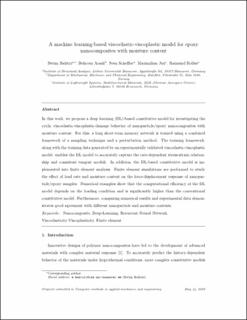| dc.contributor.author | Bahtiri, Betim | |
| dc.contributor.author | Arash, Behrouz | |
| dc.contributor.author | Scheffler, Sven | |
| dc.contributor.author | Jux, Maximilian | |
| dc.contributor.author | Rolfes, Raimund | |
| dc.date.accessioned | 2023-12-06T14:00:54Z | |
| dc.date.available | 2023-12-06T14:00:54Z | |
| dc.date.created | 2023-09-20T10:38:57Z | |
| dc.date.issued | 2023 | |
| dc.identifier.citation | Computer Methods in Applied Mechanics and Engineering. 2023, 415 . | en_US |
| dc.identifier.issn | 0045-7825 | |
| dc.identifier.issn | 1879-2138 | |
| dc.identifier.uri | https://hdl.handle.net/11250/3106266 | |
| dc.description.abstract | In this work, we propose a deep learning (DL)-based constitutive model for investigating the cyclic viscoelastic-viscoplastic-damage behavior of nanoparticle/epoxy nanocomposites with moisture content. For this, a long short-term memory network is trained using a combined framework of a sampling technique and a perturbation method. The training framework, along with the training data generated by an experimentally validated viscoelastic-viscoplastic model, enables the DL model to accurately capture the rate-dependent stress-strain relationship and consistent tangent moduli. In addition, the DL-based constitutive model is implemented into finite element analysis. Finite element simulations are performed to study the effect of load rate and moisture content on the force-displacement response of nanoparticle/epoxy samples. Numerical examples show that the computational efficiency of the DL model depends on the loading condition and is significantly higher than the conventional constitutive model. Furthermore, comparing numerical results and experimental data demonstrates good agreement with different nanoparticle and moisture contents. | en_US |
| dc.language.iso | eng | en_US |
| dc.publisher | Elsevier | en_US |
| dc.relation.ispartofseries | Computer Methods in Applied Mechanics and Engineering; | |
| dc.rights | Navngivelse 4.0 Internasjonal | * |
| dc.rights.uri | http://creativecommons.org/licenses/by/4.0/deed.no | * |
| dc.title | A machine learning-based viscoelastic–viscoplastic model for epoxy nanocomposites with moisture content | en_US |
| dc.type | Peer reviewed | en_US |
| dc.type | Journal article | en_US |
| dc.description.version | submittedVersion | en_US |
| cristin.ispublished | true | |
| cristin.fulltext | original | |
| cristin.qualitycode | 2 | |
| dc.identifier.doi | https://doi.org/10.1016/j.cma.2023.116293 | |
| dc.identifier.cristin | 2176906 | |
| dc.source.journal | Computer Methods in Applied Mechanics and Engineering | en_US |
| dc.source.volume | 415 | en_US |
| dc.source.pagenumber | 45 | en_US |

